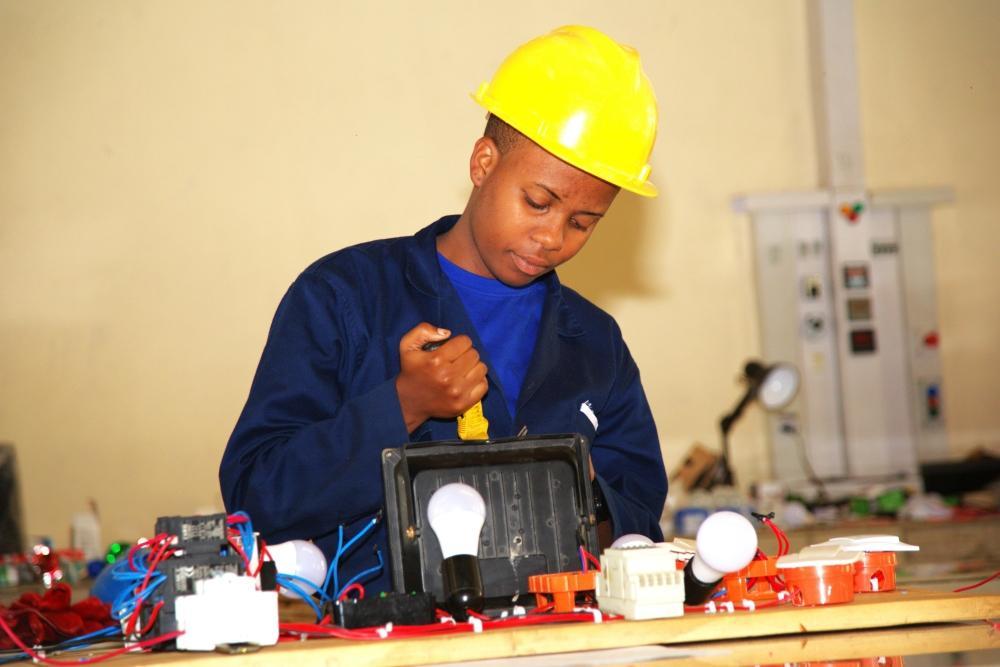Africa-Press – Rwanda. Gilbert Ndayisaba, a Senior 5 student of maths, physics and geography (MPG) at College de Butamwa in Nyarugenge District, has translated science lessons into practical solutions.
Through the school’s project-based assessment (PBA), Ndayisaba was able to apply the theoretical knowledge he acquired in class to make a small business.
“I chose to make liquid soap, an everyday essential that requires just a small capital, using the knowledge I gained during my studies,” he told The New Times. “People liked it and started buying.”
Ndayisaba now sells around 40 litres of liquid soap every week at Rwf12,000. Production costs about Rwf6,000. Less than a year since he began, the secondary school student who comes from Kamonyi said soon he will be able to pay his school fees.
“This hands-on approach has also helped me understand complex lessons more easily,” he added.
Rachel Kayitesi, a Senior 4 student at the same school, is part of a team that is working on a project to make lightning rods.
“We are building a lightning arrestor. Although we are still in the early stages, we have completed the support structures,” said Kayitesi.
“We chose this project because it meets a real need, protecting people and property from lightning. It’s a chance to apply our theoretical knowledge and encourage local innovation.”
She said the process gives them confidence that the rods will function well. Their previous successful group projects include a microscope and a solar-powered oven.
“To reduce costs, we use recycled materials like discarded boxes,” said Kayitesi. “When we can’t find something, the school provides support. Sometimes, the projects take very long because teachers have other commitments, but their guidance and materials are usually provided.”
Kayitesi sees PBAs as a shift from passive learning to active problem-solving.
“Before the PBAs, we focused mostly on reading and now, we can solve real-life problems,” she said.
“Building a microscope helped us understand challenging concepts such as magnification and focal length, which were once difficult,” she explained.
Jean-Pierre Ndagijimana, a physics teacher at the same school, acknowledged the shift.
“Previously, students only learnt soap formulas without ever producing them,” said Ndagijimana. “Today, they are tasked to get tools for making the actual product.”
He added that linking theory with practicals through project presentations has enhanced the learners’ knowledge retention and created pathways for self-employment.
Jean-Claude Iradukunda, a Senior 6 student of math, chemistry, and biology (MCB) at Groupe Scolaire Kicukiro in Kicukiro District, explained the benefits he gained from PBAs.
“One of our recent projects involved making candles,” said Iradukunda. “It was our first attempt, but we produced quality candles.”
“I made two large candles and sold them to a neighbour for Rwf2,000, having spent Rwf1,300 on the production.”
That small profit, he said, gave him confidence in the business potential of his skills.
“I have paused candle-making for another project, but I see it as something to grow later.”
He added that hands-on learning also improves understanding of difficult topics.
“We once built a model of the circulatory system. It made it easier to understand how the heart and muscles function. The model was even used in a primary school as a teaching aid. That was a proud moment,” Iradukunda said.
“Doing things practically helps me remember them better than if just wrote them down in a notebook,” he said.
Calls to reform the school timetable
Iradukunda pointed out the challenge of balancing practical work with theory.
“Time is our biggest challenge. We still have to complete theoretical lessons, and managing both becomes overwhelming, especially with a tight schedule. Teachers do their best, but it’s not easy,” he said.
Theophile Mpozingabo, a biology teacher at GS Kicukiro, also commended the National Examination and School Inspection Authority (NESA) for promoting PBAs. The teacher noted however that there needs to be some adjustments to make PBAs more efficient.
“The school day runs from 8:45 a.m. to 5:00 p.m., which makes balancing projects and class time difficult,” said Mpozingabo.
“Students sometimes skip lessons or return on weekends to complete the projects. If the curriculum and schedule included a specific time for the projects, the process would be more efficient,” he noted.
Jean-Claude Nzeyimana, the head of the Examination Department at NESA, advised schools to utilize the time allocated for co-curricular activities to find sufficient time for PBAs. Students have 40 minutes every day to do co-curricular activities, which include individual reading.
“A project can either be a short-term experiment or one that takes a longer period. If it’s a short-term experiment, such as testing the pH of common household substances using natural indicators, schools are encouraged to use the regular hours set aside for practical learning,” he explained.
However, he acknowledged that some projects may take more time, some can take two weeks, a month or even an entire term.
“For example, an investigation into the effect of different soil types on plant growth may take a whole term,” he said.
“In such cases, we recommend that schools utilise the 40-minute periods for co-curricular activity to carry out these projects.”
For More News And Analysis About Rwanda Follow Africa-Press






